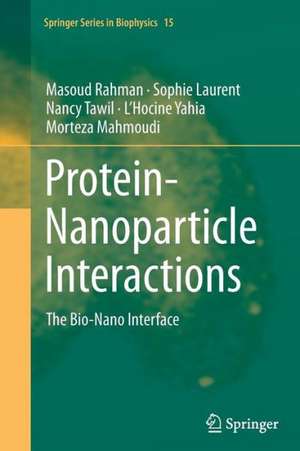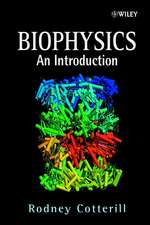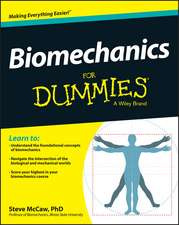Protein-Nanoparticle Interactions: The Bio-Nano Interface: Springer Series in Biophysics, cartea 15
Autor Masoud Rahman, Sophie Laurent, Nancy Tawil, L'Hocine Yahia, Morteza Mahmoudien Limba Engleză Paperback – 8 feb 2015
In this book, the importance of the physiochemical characteristics of nanoparticles for the properties of the protein corona is discussed in detail, followed by comprehensive descriptions of the methods for assessing the protein-nanoparticle interactions. The advantages and limitations of available corona evaluation methods (e.g. spectroscopy methods, mass spectrometry, nuclear magnetic resonance, electron microscopy, X-ray crystallography, and differential centrifugal sedimentation) are examined in detail, followed by a discussion of the possibilities for enhancing the current methods and a call for new techniques. Moreover, the advantages and disadvantages of protein-nanoparticle interaction phenomena are explored and discussed, with a focus on the biological impacts.
| Toate formatele și edițiile | Preț | Express |
|---|---|---|
| Paperback (1) | 630.57 lei 6-8 săpt. | |
| Springer Berlin, Heidelberg – 8 feb 2015 | 630.57 lei 6-8 săpt. | |
| Hardback (1) | 551.86 lei 39-44 zile | |
| Springer Berlin, Heidelberg – 4 iul 2013 | 551.86 lei 39-44 zile |
Din seria Springer Series in Biophysics
- 18%
 Preț: 961.72 lei
Preț: 961.72 lei - 18%
 Preț: 893.84 lei
Preț: 893.84 lei - 18%
 Preț: 958.07 lei
Preț: 958.07 lei - 20%
 Preț: 552.24 lei
Preț: 552.24 lei - 18%
 Preț: 1117.82 lei
Preț: 1117.82 lei - 15%
 Preț: 643.99 lei
Preț: 643.99 lei - 24%
 Preț: 1046.72 lei
Preț: 1046.72 lei - 18%
 Preț: 952.26 lei
Preț: 952.26 lei - 18%
 Preț: 1226.24 lei
Preț: 1226.24 lei - 18%
 Preț: 1230.66 lei
Preț: 1230.66 lei - 18%
 Preț: 938.66 lei
Preț: 938.66 lei - 20%
 Preț: 551.86 lei
Preț: 551.86 lei - 18%
 Preț: 953.65 lei
Preț: 953.65 lei - 18%
 Preț: 948.16 lei
Preț: 948.16 lei - 15%
 Preț: 645.60 lei
Preț: 645.60 lei - 18%
 Preț: 723.38 lei
Preț: 723.38 lei - 18%
 Preț: 1146.56 lei
Preț: 1146.56 lei - 24%
 Preț: 686.62 lei
Preț: 686.62 lei - 20%
 Preț: 569.85 lei
Preț: 569.85 lei - 15%
 Preț: 642.51 lei
Preț: 642.51 lei - 15%
 Preț: 644.49 lei
Preț: 644.49 lei - 15%
 Preț: 649.71 lei
Preț: 649.71 lei - 15%
 Preț: 639.59 lei
Preț: 639.59 lei - 18%
 Preț: 951.29 lei
Preț: 951.29 lei - 15%
 Preț: 639.25 lei
Preț: 639.25 lei - 9%
 Preț: 872.34 lei
Preț: 872.34 lei
Preț: 630.57 lei
Preț vechi: 741.85 lei
-15% Nou
Puncte Express: 946
Preț estimativ în valută:
120.65€ • 126.65$ • 100.15£
120.65€ • 126.65$ • 100.15£
Carte tipărită la comandă
Livrare economică 10-24 aprilie
Preluare comenzi: 021 569.72.76
Specificații
ISBN-13: 9783642440687
ISBN-10: 3642440681
Pagini: 96
Ilustrații: X, 84 p. 24 illus., 20 illus. in color.
Dimensiuni: 155 x 235 x 5 mm
Greutate: 0.15 kg
Ediția:2013
Editura: Springer Berlin, Heidelberg
Colecția Springer
Seria Springer Series in Biophysics
Locul publicării:Berlin, Heidelberg, Germany
ISBN-10: 3642440681
Pagini: 96
Ilustrații: X, 84 p. 24 illus., 20 illus. in color.
Dimensiuni: 155 x 235 x 5 mm
Greutate: 0.15 kg
Ediția:2013
Editura: Springer Berlin, Heidelberg
Colecția Springer
Seria Springer Series in Biophysics
Locul publicării:Berlin, Heidelberg, Germany
Public țintă
ResearchCuprins
The Biological Significance of ‘Nano’ interactions.- Nanoparticle and Protein Corona.- Protein Corona: Applications and Challenges.- Analytical Methods for Corona Evaluations.
Textul de pe ultima copertă
In recent years, the fabrication of nanomaterials and exploration of their properties have attracted the attention of various scientific disciplines such as biology, physics, chemistry, and engineering. Although nanoparticulate systems are of significant interest in various scientific and technological areas, there is little known about the safety of these nanoscale objects. It has now been established that the surfaces of nanoparticles are immediately covered by biomolecules (e.g. proteins, ions, and enzymes) upon their entrance into a biological medium. This interaction with the biological medium modulates the surface of the nanoparticles, conferring a “biological identity” to their surfaces (referred to as a “corona”), which determines the subsequent cellular/tissue responses. The new interface between the nanoparticles and the biological medium/proteins, called “bio-nano interface,” has been very rarely studied in detail to date, though the interest in this topic is rapidly growing.
In this book, the importance of the physiochemical characteristics of nanoparticles for the properties of the protein corona is discussed in detail, followed by comprehensive descriptions of the methods for assessing the protein-nanoparticle interactions. The advantages and limitations of available corona evaluation methods (e.g. spectroscopy methods, mass spectrometry, nuclear magnetic resonance, electron microscopy, X-ray crystallography, and differential centrifugal sedimentation) are examined in detail, followed by a discussion of the possibilities for enhancing the current methods and a call for new techniques. Moreover, the advantages and disadvantages of protein-nanoparticle interaction phenomena are explored and discussed, with a focus on the biological impacts.
In this book, the importance of the physiochemical characteristics of nanoparticles for the properties of the protein corona is discussed in detail, followed by comprehensive descriptions of the methods for assessing the protein-nanoparticle interactions. The advantages and limitations of available corona evaluation methods (e.g. spectroscopy methods, mass spectrometry, nuclear magnetic resonance, electron microscopy, X-ray crystallography, and differential centrifugal sedimentation) are examined in detail, followed by a discussion of the possibilities for enhancing the current methods and a call for new techniques. Moreover, the advantages and disadvantages of protein-nanoparticle interaction phenomena are explored and discussed, with a focus on the biological impacts.
Caracteristici
The first book to investigate protein-nanoparticle interactions in detail Gives an overview on the applications and safety issues resulting involved Written by international experts Includes supplementary material: sn.pub/extras











